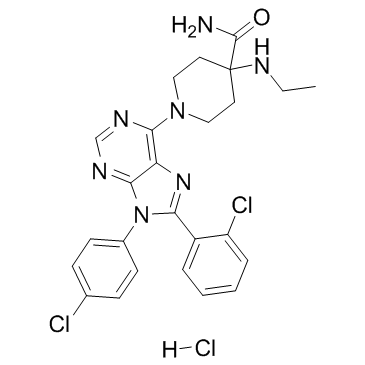| Description |
Otenabant Hydrochloride is a potent and selective cannabinoid receptor CB1 antagonist with Ki of 0.7 nM, exhibits 10,000-fold greater selectivity against human CB2 receptor.
|
| Related Catalog |
|
| Target |
Ki: 0.7 nM (CB1)
|
| In Vitro |
Otenabant HCl has low affinity with Ki of 7.6 μM for human CB2 receptors[1]. Otenabant HCl inhibits CB1 receptor with moderate unbound microsomal clearance, low hERG affinity, and adequate CNS penetration[2].
|
| In Vivo |
Otenabant acutely stimulates energy expenditure in rats and decreases the respiratory quotient indicating a metabolic switch to increased fat oxidation. Otenabant (10 mg/kg, p.o.) promotes a 9%, vehicle adjusted weight loss in a 10 day weight loss study in diet-induced obese mice[1]. Otenabant HCl reverses four cannabinoid agonistmediated behaviors (locomotor activity, hypothermia, analgesia, and catalepsy) following administration of the synthetic CB1 receptor agonist CP-55940. Otenabant HCl exhibits dose-dependent anorectic activity in a model of acute food intake in rodents and increased energy expenditure and fat oxidation[2].
|
| Kinase Assay |
Membranes are prepared from CHOK1 cells stably transfected with the human CB-1 receptor cDNA. GTPγ [35S] binding assays are performed in a 96-well FlashPlate format in duplicate using 100 pM GTPγ [35S] and 10μg membrane per well in assay buffer composed of 50 mM Tris HCl, pH 7.4, 3 mM MgCl2, pH 7.4, 10 mM MgCl2, 20 mM EGTA, 100 mM NaCl, 30 µM GDP, 0.1% bovine serum albumin, and the following protease inhibitors: 100 μg/mL bacitracin, 100 μg/mL benzamidine, 5 μg/mL aprotinin, 5 μg/mL leupeptin. The assay mix is then incubated with increasing concentrations of antagonist (10-10M to 10-5 M) for 10 min and challenged with the cannabinoid agonist CP-55,940 (10 μM). Assays are performed at 30°C for 1 h. The FlashPlates are then centrifuged at 2000 g for 10 min. Stimulation of GTPγ [35S] binding is then quantified using a Wallac Microbeta. EC50 calculations are done using Prism by GraphPad. Inverse agonism is measured in the absence of agonist.
|
| Animal Admin |
Male, 14 week old C57/Bl6/6J mice which has been maintained on a high fat diet (45% kcal from fat) for 6 weeks are selected for the DIO weight loss study. The animals body weights range at least five standard deviations from age-matched chow-fed control animals mean body weight. Mice are singly housed. The mean starting weight of all animals is 38.9±0.5 g. On day 0, mice are randomLy assigned to treatment groups (n=10 per group). Mice are dosed daily with vehicle or 10 mg/kg (p.o.) CP-945,598 over 10 days, starting approximately at 30 min before the start of the 12 h dark cycle. BW and food intake are recorded daily. Analysis of variance and comparison of means are calculated for daily and cumulative FI and cumulative BW measurements. P < 0.05 is considered statistically significant.
|
| References |
[1]. John R. Hadcock, et al. In vitro and in vivo pharmacology of CP-945,598, a potent and selective cannabinoid CB1 receptor antagonist for the management of obesity. Biochemical and Biophysical Research Communications, 2010; 394;366-371. [2]. Griffith DA, et al. Discovery of 1-[9-(4-chlorophenyl) -8-(2-chlorophenyl)- 9H-purin-6-yl] -4-ethylaminopiperidine-4-carboxylic acid amide hydrochloride (CP-945,598), a novel, potent, and selective cannabinoid type 1 receptor antagonist. JMedChem. 2009 ;5
|
